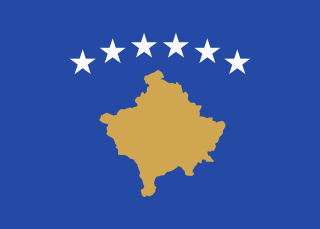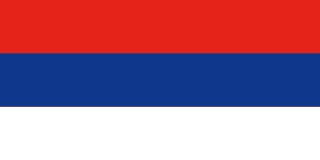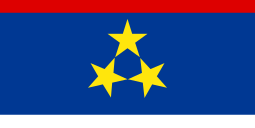
A national flag is a flag that represents and symbolizes a given nation. It is flown by the government of that nation, but can also be flown by its citizens. A national flag is typically designed with specific meanings for its colours and symbols, which may also be used separately from the flag as a symbol of the nation. The design of a national flag is sometimes altered after the occurrence of important historical events. The burning or destruction of a national flag is a greatly symbolic act.

The national flag of Slovenia features three equal horizontal bands of white (top), blue, and red, with the coat of arms of Slovenia located in the upper hoist side of the flag centred in the white and blue bands. The coat of arms is a shield with the image of Mount Triglav, Slovenia's highest peak, in white against a blue background at the centre; beneath it are two wavy blue lines representing the Adriatic Sea and local rivers, and above it are three six-pointed golden stars arranged in an inverted triangle which are taken from the coat of arms of the Counts of Celje, the great Slovene dynastic house of the late 14th and early 15th centuries.

The flag of Serbia, also known as the Tricolour, is a tricolour consisting of three equal horizontal bands, red on the top, blue in the middle, and white on the bottom, with the lesser coat of arms left of center. The same tricolour, in altering variations, has been used since the 19th century as the flag of the state of Serbia and the Serb people. The current form of the flag was adopted in 2004 and slightly redesigned in 2010.

The pan-Slavic colors—blue, white and red—were defined by the Prague Slavic Congress, 1848, based on the symbolism of the colors of the flag of Russia, which was introduced in the late 17th century. Historically, many Slavic nations and states adopted flags and other national symbols that used some combination of those three colors. Slavic countries that use or have used the colors include Russia, Yugoslavia, Czechoslovakia, Czech Republic, Slovakia, Croatia, Serbia and Slovenia, whereas Belarus, Bosnia and Herzegovina, Bulgaria, Montenegro, North Macedonia, Poland and Ukraine use different color schemes.

The national flag of Croatia or The Tricolour is one of the state symbols of Croatia. It consists of three equal size, horizontal stripes in colours red, white and blue. In the middle is the coat of arms of Croatia.

The coat of arms of the Republic of Croatia consists of one main shield and five smaller shields which form a crown over the main shield. The main coat of arms is a checkerboard (chequy) that consists of 13 red and 12 white fields. It is also informally known in Croatian as šahovnica. The five smaller shields represent five different historical regions within Croatia.

The national flag of Montenegro has a red field with gold border and the coat of arms of Montenegro in its center. It was officially adopted on 13 July 2004, when the then Republic of Montenegro was a constituent of the State Union of Serbia and Montenegro, and its precise specification was standardized on 16 September 2004. The flag was retained after Montenegrin independence from Serbia in 2006, and mandated by Article 4 of the Constitution of Montenegro adopted in 2007.

The flag of Bosnia and Herzegovina contains a medium blue field with a yellow right triangle separating said field, and there are seven full five-pointed white stars and two half stars top and bottom along the hypotenuse of the triangle.

The flag of Uganda was adopted on 9 October 1962, the date that Uganda became independent from the British Empire. It consists of six equal horizontal bands of black (top), yellow, red, black, yellow, and red (bottom); a white disc is superimposed at the centre and depicts the national symbol, a grey crowned crane, facing the hoist's side.

The coat of arms of the Republic of Serbia consists of two main heraldic symbols which represent the identity of the Serbian state and Serbian people across the centuries: the Serbian eagle and the Serbian cross. The coat of arms also features the Serbian historical crown; while unusual for republics, it is not unprecedented, as can be seen in coat of arms of numerous European countries with republican form of government. However, Serbia's coat of arms still retains strong monarchist elements absent from the other republics, including the mantle and pavillon found in the greater coat of arms of some modern and many historical monarchies.

The Serbian cross, also known as the Firesteels, is one of national symbols of Serbia. It is present on the coat of arms and flag of Serbia. The cross is based on a tetragrammic cross emblem of the Palaiologos dynasty of the Byzantine Empire, with the difference in Serbian use being that the cross is usually white on a red background, rather than gold on a red background. Serbian cross was adopted from Roman empire eagle and Byzantine cross which represents east Roman empire in middle-age before Ottoman occupation.
A triband is a vexillological style which consists of three stripes arranged to form a flag. These stripes may be two or three colours, and may be charged with an emblem in the middle stripe. All tricolour flags are tribands, but not all tribands are tricolour flags, which requires three unique colours.

There are two coats of arms in official use in the Autonomous Province of Vojvodina, the coat of arms of Vojvodina and the Traditional coat of arms of Vojvodina. Two coats of arms are given the equal status in the Provincial Assembly Decision on the Appearance and Usage of Symbols and Traditional Symbols of AP Vojvodina adopted in 2016.

The flag of Republika Srpska within Bosnia and Herzegovina was adopted on 12 May 1992. The flag is a rectangular tricolor with three equal horizontal bands of red, blue and white. It is almost identical to the civil flag of Serbia, but with different aspect ratio of 1:2 instead of 2:3 and slightly different color shades. The flag is very similar to that of Misiones Province in Argentina and Russia.

The flag of the Republic of Kosovo was adopted by the Assembly of the Republic of Kosovo immediately following the unilateral declaration of independence of Kosovo on 17 February 2008. The flag design emerged from an international competition, organized by an informal group from the Provisional Institutions of Self-Government known as the Kosovo Unity Team, which attracted almost one thousand entries. The winning design was proposed by Muhamer Ibrahimi. It shows six white stars in an arc above a golden map of Kosovo, all on a blue field. The stars symbolize Kosovo's six major ethnic groups: Albanians, Serbs, Bosniaks, Turks, Romani, and Gorani.

Serbian heraldry involves the study and use of coats of arms and other heraldic insignia in the country of Serbia or by Serbs. The Serbian government is the armiger in Serbia, exercising that right under the advice of the Serbian Heraldry Society, a learned society devoted to the study and creation of heraldry, specifically Serbian heraldry.

The flag of Yugoslavia was the official flag of the Yugoslav state from 1918 to 1992. The flag's design and symbolism are derived from the Pan-Slavic movement, which ultimately led to the unification of the South Slavs and the creation of a united south-Slavic state in 1918.

The flag of Croats of Serbia is one of the main symbols of the Croat minority in Serbia.

The flag of the Serbs of Croatia is the official symbol of the Serb national minority in Croatia. It was introduced into official use throughout the country on 9 April 2005 based on the decision of the Serb National Council, an elected political, consulting and coordinating body which acts as a form of self-government and autonomous cultural institution of the Serbs of Croatia. The council received consent of the Council for National Minorities of the Republic of Croatia before the decision. At the time of the statewide introduction, the flag was already officially used in Eastern Slavonia since the 14 November 1997 decision of the Joint Council of Municipalities made at the final stage of the UNTAES deployment in the region.

























